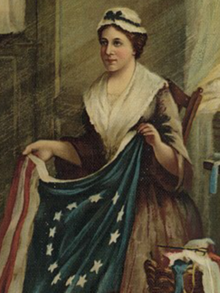
Back إليزابيث روس Arabic اليزابيث روس (مصممه من مملكه بريطانيا العظمى) ARZ Betsy Ross Catalan Betsy Rossová Czech Betsy Ross Danish Betsy Ross German Betsy Ross Spanish Betsy Ross Estonian بتسی راس Persian Betsy Ross French
Betsy Ross | |
|---|---|
 Posthumous depiction of Ross, from 1893 | |
| Born | Elizabeth Griscom January 1, 1752 |
| Died | January 30, 1836 (aged 84) Philadelphia, Pennsylvania, U.S. |
| Occupation | Upholsterer |
| Years active | 1768–1833 |
| Spouses | John Ross
(m. 1773; died 1775)Joseph Ashburn
(m. 1777; died 1780)John Claypoole
(m. 1783; died 1817) |
| Children | 7 |
| Parents |
|
| Family |
|
| Signature | |
Elizabeth Griscom Ross (née Griscom;[1] January 1, 1752 – January 30, 1836), also known by her second and third married names, Ashburn and Claypoole,[1] was an American upholsterer who was credited by her relatives in 1870[2] with making the second official U.S. flag,[3] accordingly known as the Betsy Ross flag. Though most historians dismiss the story,[4] Ross family tradition[5][6] holds that General George Washington, commander-in-chief of the Continental Army and two members of a congressional committee—Robert Morris and George Ross—visited Mrs. Ross in 1776.[7] Mrs. Ross convinced George Washington to change the shape of the stars in a sketch of a flag he showed her from six-pointed to five-pointed by demonstrating that it was easier and speedier to cut the latter.[8] However, there is no archival evidence or other recorded verbal tradition to substantiate this story of the first U.S. flag. It appears that the story first surfaced in the writings of her grandson in the 1870s (a century after the fact), with no mention or documentation in earlier decades.[9]
Ross made flags for the Pennsylvanian navy during the American Revolution.[10] After the Revolution, she made U.S. flags for over 50 years, including 50 garrison flags for the U.S. Arsenal on the Schuylkill River during 1811.[11] The flags of the Pennsylvania navy were overseen by the Pennsylvania Navy Board. The board reported to the Pennsylvania Provincial Assembly's Committee of Safety. In July 1775, the President of the Committee of Safety was Benjamin Franklin. Its members included Robert Morris and George Ross. At that time, the committee ordered the construction of gunboats that would eventually need flags as part of their equipment. As late as October 1776, Captain William Richards was still writing to the committee or Council of Safety to request the design that he could use to order flags for their fleet.[12]
Ross was one of those hired to make flags for the Pennsylvanian fleet. An entry dated May 29, 1777, in the records of the Pennsylvania Navy Board includes an order to pay her for her work.[13] It is worded as follows:
An order on William Webb to Elizabeth
Ross for fourteen pounds twelve shillings and two
pence for Making Ships Colours [etc.] put into William
Richards store……………………………………….£14.12.2[14]
The Pennsylvania navy's ship color included (1) an ensign; (2) a long, narrow pennant; and (3) a short, narrow pennant. The ensign was a blue flag with 13 stripes—seven red stripes and six white stripes in the flag's canton (upper-left-hand corner). It was flown from a pole at the rear of the ship. The long pennant had 13 vertical, red-and-white stripes near the mast; the rest was solid red. It flew from the top of the ship's mainmast, the center pole holding the sails. The short pennant was solid red, and flew from the top of the ship's mizzenmast—the pole holding the ship's sails nearest the stern (rear of the ship).[15]
- ^ a b Addie Guthrie Weaver, "The Story of Our Flag ...", 2nd Edition, A. G. Weaver, publ., 1898, p. 73
- ^ Balderston, Lloyd (1917). The Evolution of the American Flag. Philadelphia: Ferris and Leach., Preface (first page) and p. 113
- ^ "Short History of the United States Flag". November 6, 2019.
The first 'official' flag was 'the Continental Colors,' also known as the 'Grand Union Flag,' which consisted of thirteen red and white stripes and the United Kingdom's flag in the upper-left-hand corner, also known as the canton.'
- ^ "The Truth About Betsy Ross". www.history.org. Archived from the original on August 3, 2018.
- ^ The Indiana Progress, 22 Jun 1876, Thu, Page 9. Obituary of Margaret Donaldson Boggs, descendant of Betsy Ross
- ^ Balderston, p.47-49.
- ^ Balderston, p. 48.
- ^ Balderston, pp. 47–48.
- ^ Leepson, Marc (June 12, 2011). "Five myths about the American flag". The Washington Post. p. B2. Archived from the original on July 15, 2017.
- ^ Furlong, William Rea; McCandless, Byron (1981). So Proudly We Hail: The History of the United States Flag. Washington, D.C.: Smithsonian Institution Press. p. 117.
- ^ "Betsy Ross House: The Flag". historicphiladelphia.org. Retrieved September 4, 2019.
- ^ Richardson, Edward W. (1982). Standards and Colors of the American Revolution. University of Pennsylvania Press. pp. 111–112.
- ^ Richardson, p. 112.
- ^ Miller, Marla R (2010). Betsy Ross and the Making of America. New York, NY: Henry Holt and Company. pp. 244–245, Illustration 10. ISBN 9780805082975.
- ^ Moeller, Henry W. (January 2002). "Two Early American Ensigns on the Pennsylvania State Arms". NAVA News (173): 2.
© MMXXIII Rich X Search. We shall prevail. All rights reserved. Rich X Search